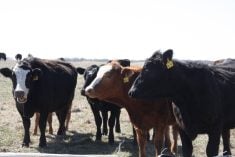This cattle market information is selected from the weekly report from Canfax, a division of the Canadian Cattlemen’s Association. More market information, analysis and statistics are available by becoming a Canfax subscriber by calling 403-275-5110 or at www.canfax.ca.
Sluggish fed trade
Alberta direct cattle trade was sluggish last week. Strong wholesale demand and supply chain fear fuelled stronger beef values, while COVID-19 in the workforce continued to restrict slaughter production and product distribution.
Read Also

Volatile temperatures expected for this winter
DTN is forecasting a lot of temperature variability in the Canadian Prairies this winter. Precipitation should be close to average.
With high feeding costs and feed grain supply disruptions, getting kill hooks booked is the big marketing motivator.
Cash trade last week saw dressed sales reported from $260-$278 per hundredweight delivered. The average fed steer rail price mid-point last week was $267 per cwt. delivered. Weighted average steer prices surged almost $5 per cwt. higher than the previous week to $160.29 per cwt. Heifer trade volume was too slight to establish a trend.
Delivery dates on last week’s offering were reported for the second half of February. Western Canadian fed slaughter for the week ending Jan. 15 continued sluggish, down three percent from the previous week at 35,685 head.
Year to date, western Canadian fed slaughter was 10 percent below year ago, totalling 72,635 head. Canadian fed cattle/cow exports to the United States for the first week of 2022 were 29 percent larger than a year ago at 11,163 head.
Ontario saw moderate sale volumes last week with prices fully steady with the previous week at $290 per cwt. delivered.
Reduced slaughter production is anticipated this week, and it’s unlikely packers will be able boost throughput enough to work through backlogged supplies.
Cow slaughter rises
January is traditionally a big cow slaughter month, but volumes in western Canada are larger than expected. Non-fed numbers through commercial auction facilities have been much lighter than normal, yet weekly cow slaughter volumes are the largest in 10 months.
Competition on the cash market was decent with both major packers buying cows through the ring. Trading $2.75 per cwt. higher, D2 cow prices are at the highest point since early October, averaging $77.42 per cwt. D3s averaged $66.
January is usually a tough month for the butcher bull market. In 13 of the past 15 years, butcher bull prices have established first quarter lows in January. Last week they averaged $100.96 per cwt.
For January, Alberta and Ontario cow prices are on track to average in the mid $70s per cwt. For Ontario, this would be the highest January average since 2017. In Alberta it would be second lowest average in eight years.
Over the past five years, the average increase from fall lows to spring highs is 31 percent. Last fall’s low occurred at $61 per cwt. and prices have already rallied 26 percent. Over the past five years the largest increase from fall low to spring high was 51 percent in 2020 to 2021. A 51 percent increase seems achievable this year.
Auction volumes rebound
After a slow start in early January, Alberta auction volumes rebounded sharply and year-to-date volumes are almost equal with last year. Prices were mixed, but pressure was noted on heavier feeders over 700 pounds.
Since the start of the year, the western Canadian feeder index has declined $6 per cwt., while the calf index has fallen $3.75 per cwt.
In Alberta, Saskatchewan and Manitoba, the largest year-over-year price increase is on steers heavier than 900 lb., $19- $23 per cwt. higher than a year ago. In all three provinces there is little price difference between 850 and 950 lb. steers. The Alberta 850 lb. feeder basis was reported at -$10.80 per cwt., the weakest basis for the second half of January since 2015.
Based on the latest Can fax Trends report, 850 lb. yearling steers placed in January have breakevens in the $183 per cwt. area, targeting the June fed market. Over the past three years, yearling steers bought in January and sold in June lost on average $125 per head. The five-year average is negative $25 per head.
Grain shipments from the U.S. are behind schedule, which could moderate demand for bunk replacements if the issue persists.
The bred cow market was lightly tested last week. Alberta bred cows traded from $1,200-$2,025 per head and averaged $1,550, steady with late December and $175 per head lower than last year.
Tight feed supplies and expensive feed prices are the biggest price-limiting factors for the bred cow market.














